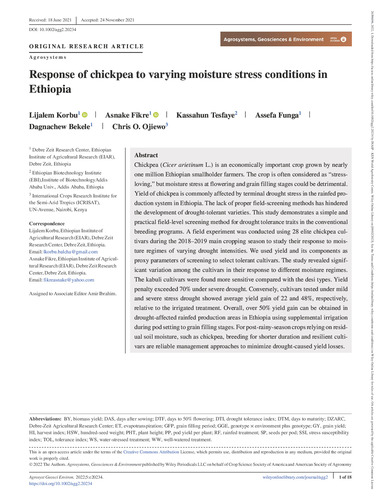Response of chickpea to varying moisture stress conditions in Ethiopia
Abstract
Chickpea (Cicer arietinum L.) is an economically important crop grown by nearly one million Ethiopian smallholder farmers. The crop is often considered as “stress-loving,” but moisture stress at flowering and grain filling stages could be detrimental. Yield of chickpea is commonly affected by terminal drought stress in the rainfed production system in Ethiopia. The lack of proper field-screening methods has hindered the development of drought-tolerant varieties. This study demonstrates a simple and practical field-level screening method for drought tolerance traits in the conventional breeding programs. A field experiment was conducted using 28 elite chickpea cultivars during the 2018–2019 main cropping season to study their response to moisture regimes of varying drought intensities. We used yield and its components as proxy parameters of screening to select tolerant cultivars. The study revealed significant variation among the cultivars in their response to different moisture regimes. The kabuli cultivars were found more sensitive compared with the desi types. Yield penalty exceeded 70% under severe drought. Conversely, cultivars tested under mild and severe stress drought showed average yield gain of 22 and 48%, respectively, relative to the irrigated treatment. Overall, over 50% yield gain can be obtained in drought-affected rainfed production areas in Ethiopia using supplemental irrigation during pod setting to grain filling stages. For post-rainy-season crops relying on residual soil moisture, such as chickpea, breeding for shorter duration and resilient cultivars are reliable management approaches to minimize drought-caused yield losses.

